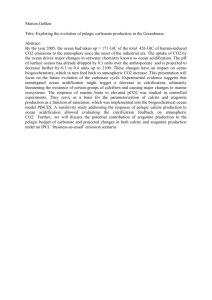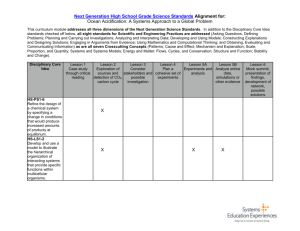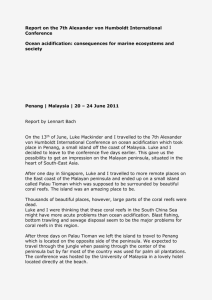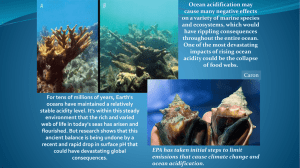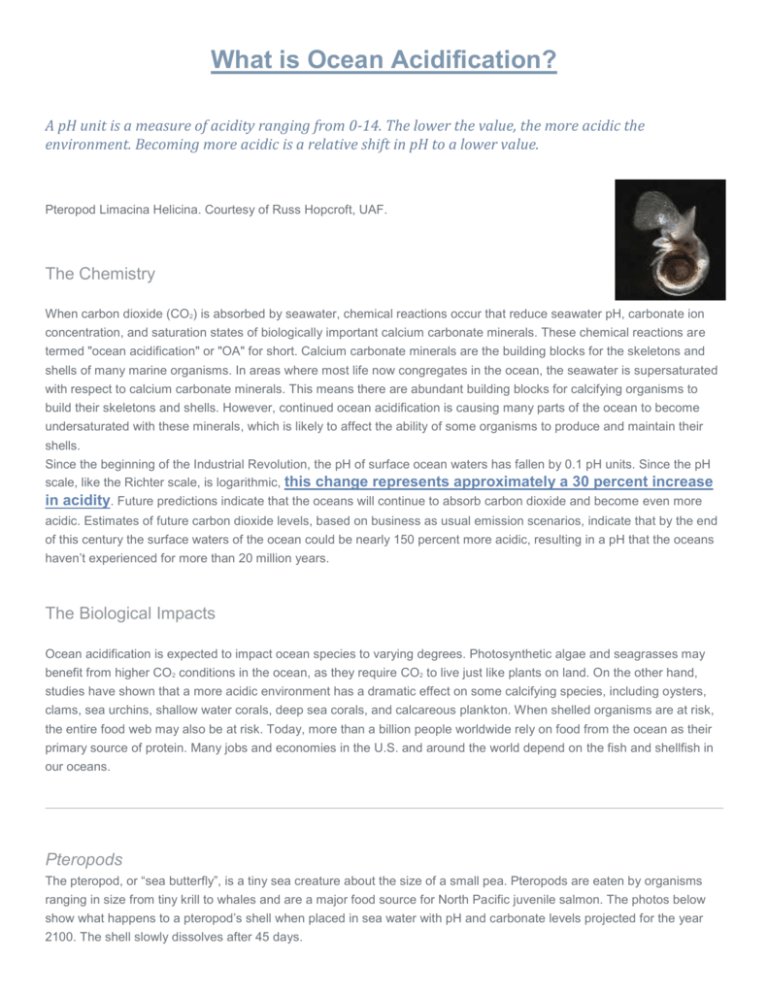
What is Ocean Acidification?
A pH unit is a measure of acidity ranging from 0-14. The lower the value, the more acidic the
environment. Becoming more acidic is a relative shift in pH to a lower value.
Pteropod Limacina Helicina. Courtesy of Russ Hopcroft, UAF.
The Chemistry
When carbon dioxide (CO2) is absorbed by seawater, chemical reactions occur that reduce seawater pH, carbonate ion
concentration, and saturation states of biologically important calcium carbonate minerals. These chemical reactions are
termed "ocean acidification" or "OA" for short. Calcium carbonate minerals are the building blocks for the skeletons and
shells of many marine organisms. In areas where most life now congregates in the ocean, the seawater is supersaturated
with respect to calcium carbonate minerals. This means there are abundant building blocks for calcifying organisms to
build their skeletons and shells. However, continued ocean acidification is causing many parts of the ocean to become
undersaturated with these minerals, which is likely to affect the ability of some organisms to produce and maintain their
shells.
Since the beginning of the Industrial Revolution, the pH of surface ocean waters has fallen by 0.1 pH units. Since the pH
scale, like the Richter scale, is logarithmic, this change represents approximately a 30 percent increase
in acidity. Future predictions indicate that the oceans will continue to absorb carbon dioxide and become even more
acidic. Estimates of future carbon dioxide levels, based on business as usual emission scenarios, indicate that by the end
of this century the surface waters of the ocean could be nearly 150 percent more acidic, resulting in a pH that the oceans
haven’t experienced for more than 20 million years.
The Biological Impacts
Ocean acidification is expected to impact ocean species to varying degrees. Photosynthetic algae and seagrasses may
benefit from higher CO2 conditions in the ocean, as they require CO2 to live just like plants on land. On the other hand,
studies have shown that a more acidic environment has a dramatic effect on some calcifying species, including oysters,
clams, sea urchins, shallow water corals, deep sea corals, and calcareous plankton. When shelled organisms are at risk,
the entire food web may also be at risk. Today, more than a billion people worldwide rely on food from the ocean as their
primary source of protein. Many jobs and economies in the U.S. and around the world depend on the fish and shellfish in
our oceans.
Pteropods
The pteropod, or “sea butterfly”, is a tiny sea creature about the size of a small pea. Pteropods are eaten by organisms
ranging in size from tiny krill to whales and are a major food source for North Pacific juvenile salmon. The photos below
show what happens to a pteropod’s shell when placed in sea water with pH and carbonate levels projected for the year
2100. The shell slowly dissolves after 45 days.
Photo credit: David Liittschwager/National Geographic Stock. Used with permission. All rights reserved. National
Geographic Images.
Shellfish
In recent years, there have been near total failures of
developing oysters in both aquaculture facilities and natural
ecosystems on the West Coast. These larval oyster failures
appear to be correlated with naturally occurring upwelling
events that bring low pH waters undersaturated in aragonite
as well as other water quality changes to nearshore
environments. Lower pH values occur naturally on the West
Coast during upwelling events, but a recent observations
indicate that anthropogenic CO2 is contributing to seasonal
undersaturation. Low pH may be a factor in the current
oyster reproductive failure; however, more research is
needed to disentangle potential acidification effects from
other risk factors, such as episodic freshwater inflow, pathogen increases, or low dissolved oxygen. It is premature to
conclude that acidification is responsible for the recent oyster failures, but acidification is a potential factor in the current
crisis to this $100 million a year industry, prompting new collaborations and accelerated research on ocean
acidification and potential biological impacts.
Photo: Freshly harvested oysters from Yaquina Bay, Oregon (Credit: NOAA)
Coral
Many marine organisms that produce calcium carbonate shells or skeletons are negatively impacted by increasing
CO2levels and decreasing pH in seawater. For example, increasing ocean acidification has been shown to significantly
reduce the ability of reef-building corals to produce their skeletons. In a recent paper, coral biologists reported that
ocean acidification could compromise the successful fertilization, larval settlement and survivorship of Elkhorn coral, an
endangered species. These research results suggest that ocean acidification could severely impact the ability of coral
reefs to recover from disturbance. Other research indicates that, by the end of this century, coral reefs may erode faster
than they can be rebuilt. This could compromise the long-term viability of these ecosystems and perhaps impact the
estimated one million species that depend on coral reef habitat. For more information on the impact of ocean acidification
on coral, see NOAA's Coral Reef Watch website.
Ocean Acidification: An Emerging Global Problem
Ocean acidification is an emerging global problem. Over the last decade, there has been much focus in the ocean science
community on studying the potential impacts of ocean acidification. Since sustained efforts to monitor ocean acidification
worldwide are only beginning, it is currently impossible to predict exactly how ocean acidification impacts will cascade
throughout the marine food chain and affect the overall structure of marine ecosystems. With the pace of ocean
acidification accelerating, scientists, resource managers, and policymakers recognize the urgent need to strengthen the
science as a basis for sound decision making and action.
Facts:
40%: The increase in atmospheric carbon dioxide (CO2) levels since the start of the industrial revolution.
26%: The increase in ocean acidity from preindustrial levels to today.
~ 170%: The projected increase in ocean acidity by 2100 compared with preindustrial levels if high
CO2 emissions continue (RCP* 8.5).
10 times: The current rate of acidification is over 10 times faster than any time in the last 55 million years.
24 million: The number of tons of CO2 the ocean absorbs every day.
Analysis Questions:
After watching the movie “Acid Test” and reading the PPT provided as well as the article above, answer the following questions (CT #5) on
your own paper.
1. Why is increasing ocean acidification considered a very serious problem?
2. If acid levels in the ocean rise sharply during your lifetime how might this
affect you?
3. Can you think of ways in which you might be contributing to this problem?
4. What could you do to reduce your impact? Be specific.

